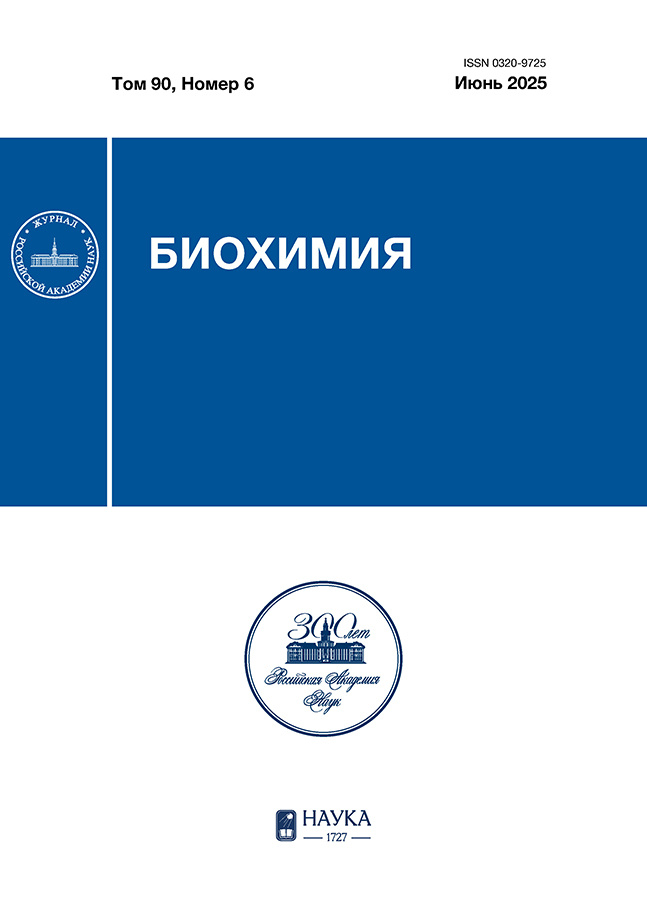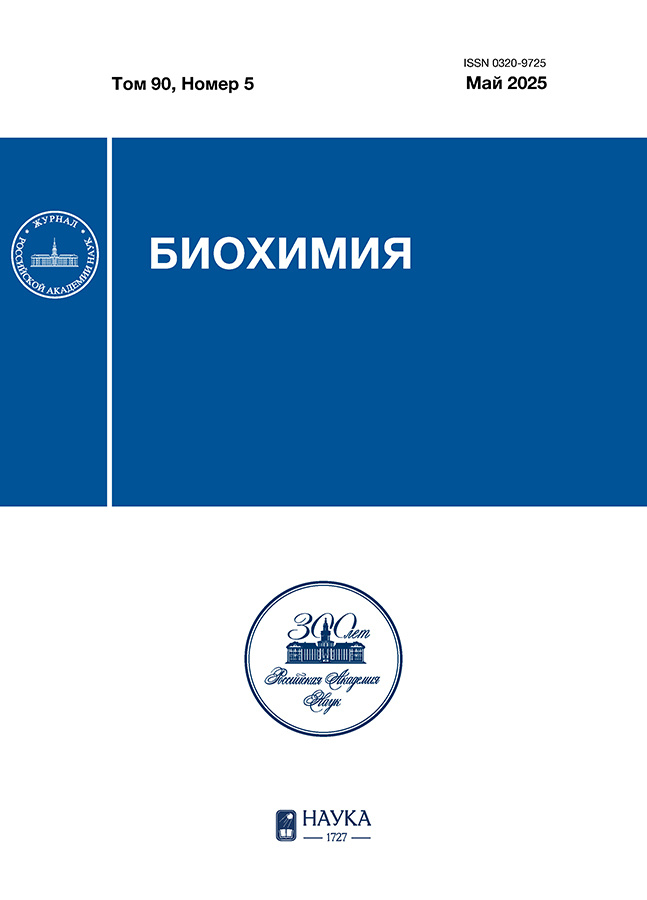Том 90, № 5 (2025)
Статьи
Ингибирование этопозид-индуцированного повреждения ДНК у клеток острого моноцитарного лейкоза в условиях гиперклеточного провоспалительного микроокружения
Аннотация
Возникновение устойчивости у клеток острого моноцитарного лейкоза (ОМоЛ; ОМЛ М5) к действию противоопухолевых агентов является одной из основных причин крайне низкой выживаемости и излечиваемости пациентов с диагностированным ОМоЛ. Хорошо известно, что клетки ОМЛ обладают «воспалительным» фенотипом и формируют уникальное провоспалительное микроокружение. Ранее мы выявили повышение устойчивости клеток ОМоЛ человека ТНР-1 к действию ингибиторов ДНК-топоизомераз I и II (топотекан, этопозид, доксорубицин) в in vitro модели, имитирующей условия провоспалительного микроокружения – трехмерной долговременной культуре клеток высокой плотности. В данном исследовании с помощью методов флуоресцентной микроскопии и спектрофлуориметрии, метода ДНК-комет, вестерн-блоттинга, анализа дифференциальной экспрессии генов и проточной цитометрии мы показали, что повышение резистентности к действию ингибиторов ДНК-топоизомераз, в частности к этопозиду, у клеток ОМоЛ ТНР-1 в условиях гиперклеточного провоспалительного микроокружения реализуется за счет снижения одно- и двухцепочечных разрывов ДНК и, соответственно, ответа на повреждение ДНК, а также может быть связано с выраженной активацией сигнальных путей интерферонов I и II типов, NF-κB/STAT-зависимых сигнальных путей, происходящей на фоне существенного подавления активности транскрипционных факторов семейств Myc и E2F. Результаты этой работы открывают новые представления о роли провоспалительной активации в повышении устойчивости клеток ОМЛ к гибели, индуцированной действием ингибиторов ДНК-топоизомераз.
 595-610
595-610


Дифференциальная экспрессия циклических РНК во фронтальной коре мозга крыс в условиях ишемии-реперфузии
Аннотация
Циклические РНК (циклоРНК) – ковалентно замкнутые некодирующие РНК, обладающие повышенной метаболической стабильностью и способные к регуляции экспрессии генов. ЦиклоРНК рассматриваются как потенциальные биомаркеры и мишени терапии для различных заболеваний, в том числе для ишемического инсульта. Модель обратимой окклюзии правой средней мозговой артерии (tMCAO) активно используется в транскриптомике инсульта. В настоящей работе с помощью полногеномного РНК-секвенирования мы изучили профиль экспрессии циклоРНК в участке фронтальной коры мозга крыс через 24 ч после tMCAO. Мы идентифицировали 64 дифференциально экспрессированных циклоРНК (кратность изменения > 1,5; Padj < 0,05), которые преимущественно повысили свой уровень экспрессии относительно ложнооперированных животных. По данным МРТ, изучаемый участок фронтальной коры включал зону пенумбры, выживание клеток в которой имеет важное значение для восстановления после инсульта. Также, используя ранее полученные нами данные о дифференциальной экспрессии мРНК в данной области мозга, мы биоинформатически спрогнозировали регуляторные сети циклоРНК–микроРНК–мРНК. Функциональный анализ данных сетей показал, что гены, экспрессия которых может зависеть от активности циклоРНК при ишемии, ответственны за синаптическую передачу сигналов и воспалительную реакцию. Наше исследование показывает значимую роль циклоРНК-опосредованной регуляции транскриптома в ассоциированной с пенумброй области мозга при ишемии и позволяет рассматривать циклоРНК как потенциальные мишени для новых стратегий терапии инсульта и постинсультных осложнений.
 611-626
611-626


Изолированный из генома промотор гена FOS человека гиперактивирован и малочувствителен к изменению Na+i/K+i-соотношения
Аннотация
Показано, что изменения внутриклеточных концентраций ионов Na+ и K+ влияют на экспрессию гена FOS. В данной работе мы получили генетическую конструкцию, кодирующую TurboGFP-dest1 под управлением промотора FOS человека (−549; +155), и оценили изменение экспрессии TurboGFP-dest1 при воздействии одновалентных катионов металлов в клетках HEK 293T. Амплификация последовательности промотора FOS с использованием геномной ДНК человека в качестве матрицы проходила успешно только в присутствии ионов Li+. Инкубация клеток в присутствии уабаина и в среде, где ионы Na+ были полностью замещены ионами Li+, вызывала накопление в клетках Na+ и Li+ соответственно. Кроме того, эти воздействия приводили к увеличению уровня мРНК эндогенного FOS и средней интенсивности флуоресценции TurboGFP-dest1 в трансфицированных клетках. Количество мРНК TurboGFP-dest1 было значительно больше по сравнению с мРНК эндогенного FOS и слабо изменялось под действием одновалентных катионов металлов.
 627-635
627-635


Метод мультиплексного иммунопрофилирования клеток крови мышей с высокочувствительной детекцией репортёрной β-галактозидазы LacZ
Аннотация
Бактериальная β-галактозидаза (LacZ) широко использовалась в качестве репортёра при создании линий мышей для изучения экспрессии генов. Однако LacZ-репортёры имеют ограничения, связанные с присутствием эндогенной β-галактозидазы в клетках, а также низкой чувствительностью и проникающей способностью существующих субстратов для обнаружения активности LacZ. Для анализа экспрессии генов методом многоцветной проточной цитометрии в живых клетках требуются точные, чувствительные, нетоксичные флуоресцентные индикаторы. В этом исследовании мы оценили эффективность способного к иммобилизации флуоресцентного зонда SPiDER-βGal при детекции LacZ в основных популяциях клеток крови репортёрных мышей методом многоцветной проточной цитометрии. Результаты показали, что SPiDER-βGal имел высокую чувствительность к LacZ, однако обнаруживал и эндогенную β-галактозидазу. Наибольшую фоновую активность имели миелоидные клетки крови. Использование ингибитора протонных помп Бафиломицина А1 позволило повысить точность обнаружения LacZ в популяциях лейкоцитов за счёт подавления эндогенной активности вследствие повышения pH в лизосомах. Продление инкубации с субстратом SPiDER-βGal до 60 минут увеличивало чувствительность метода на порядок. Таким образом, применение специфических ингибиторов протонного транспорта в лизосомах позволяет повысить разрешающую способность анализа активности LacZ в клетках крови репортёрных животных, что может быть использовано для мультиканальной сортировки живых лейкоцитов по уровню экспрессии LacZ и поверхностным маркерам для дальнейших функциональных и генетических исследований.
 636-644
636-644


Оценка разнообразия репертуара иммуноглобулинов человека после криоконсервации B-клеток и их рестимуляции
Аннотация
Криоконсервация мононуклеарных клеток периферической крови человека широко применяется в различных клинических и исследовательских целях. Однако до сих пор распространено мнение, что для наиболее точного анализа исходного репертуара иммуноглобулинов как в количественном, так и в качественном аспектах следует использовать только свежевыделенные В-клетки. В данном исследовании с использованием широкомасштабного секвенирования мы изучили, как изменяется репертуар иммуноглобулинов после криоконсервации В-клеток и их последующего размораживания при различных условиях. Основной целью исследования являлось сравнение репертуаров иммуноглобулинов после криоконсервации В-клеток – как в условиях с последующей рестимуляцией in vitro, так и без дополнительного воздействия. Результаты исследования демонстрируют сохранность репертуара иммуноглобулинов при замораживании В-клеток человека в подобранных условиях. Полученные данные подчёркивают потенциальную ценность применения данного подхода как в фундаментальных исследованиях, так и в клинической практике.
 645-655
645-655


Ускоренная пробоподготовка образцов для точного количественного протеомного анализа клеток и тканей методом ультрабыстрой масс-спектрометрии
Аннотация
Современные достижения в области жидкостной хроматографии и масс-спектрометрии (ВЭЖХ-МС1) сделали возможным проведение полнопротеомного количественного анализа за минуты, достигая производительности до 1000 анализов в сутки. В связи с этим актуален пересмотр подходов к пробоподготовке для протеомики, соответственно скорости анализа ВЭЖХ-МС1. Несмотря на существование методов ускоренной пробоподготовки в течение десятилетий, их применение в количественной сверхбыстрой протеомике и комплексное сравнение эффективности до настоящего времени не исследовались. В данной работе проведено сравнение методов ускоренного восстановления, алкилирования и гидролиза белков с помощью ультразвукового, микроволнового излучений и при повышенной температуре. Валидация выполнена с использованием количественного анализа без меток протеомов Saccharomyces cerevisiae, клеточных линий человека и побегов озимой пшеницы методами ВЭЖХ-МС/МС и ВЭЖХ-МС1 без спектров фрагментации (метод DirectMS1). Все эксперименты проводились с использованием коротких хроматографических градиентов от 5 до 16 мин. Для оценки точности количественного анализа использовались количественные стандарты – смеси белков человека и дрожжей. Полученные результаты демонстрируют, что сокращение времени пробоподготовки не влияет на воспроизводимость идентификаций пептидов и белков, несмотря на снижение эффективности восстановления, алкилирования и ферментативного гидролиза белков. Также было обнаружено, что ферментативный гидролиз в течение 30 мин при СВЧ-воздействии и классический 18-часовой гидролиз обеспечили сопоставимую точность количественного анализа при сверхбыстром анализе методом DirectMS1.
 656-672
656-672


Гиперэкспрессия глицеролкиназы подавляет синтез липидов, но повышает мембранный потенциал митохондрий и активность термогенеза в адипоцитах
Аннотация
Ожирение и сахарный диабет 2-го типа – одни из основных факторов, способствующих росту смертности и инвалидизации в современном мире. В связи с этим приоритетной задачей является разработка новых методов, включая генную и клеточную инженерию, для создания эктопических термогенных жировых депо, способных рассеивать избыток энергии. В данной работе мы изучали гиперэкспрессию глицеролкиназы (ГК) – ключевого фермента футильного триацилглицеридного цикла (ТАГ-цикла) для формирования термогенных адипоцитов. Белок-кодирующую последовательность ГК амплифицировали на основе мРНК печени мыши и доставляли в адипоциты путем лентивирусной трансдукции. Метаболизм адипоцитов анализировали с помощью радиоизотопного мониторинга [3H]- и [14С]-меченых аналогов глюкозы. Мембранный потенциал митохондрий, термогенез и морфологию липидных капель оценивали с использованием флуоресцентных зондов JC-1, ERthermAC и BODIPY493/503 соответственно. Лентивирусная доставка гена ГК увеличивает в адипоцитах экспрессию мРНК в 130 раз и уровень белка – на 30%. Гиперэкспрессия ГК усиливает захват глюкозы адипоцитами, а также подавляет синтез и реэтерификацию жирных кислот, не изменяя морфологию липидных капель. Рост поглощения глюкозы при гиперэкспрессии ГК ассоциирован с ростом митохондриального потенциала и стимуляцией термогенеза. Гиперэкспрессия ГК улучшает метаболический профиль адипоцитов, что может способствовать устранению метаболических нарушений, связанных с ожирением, за счет повышения утилизации избыточной глюкозы в ходе термогенеза. Тем не менее детальные механизмы, лежащие в основе стимуляции этих процессов, требуют дальнейшего изучения.
 673-687
673-687













